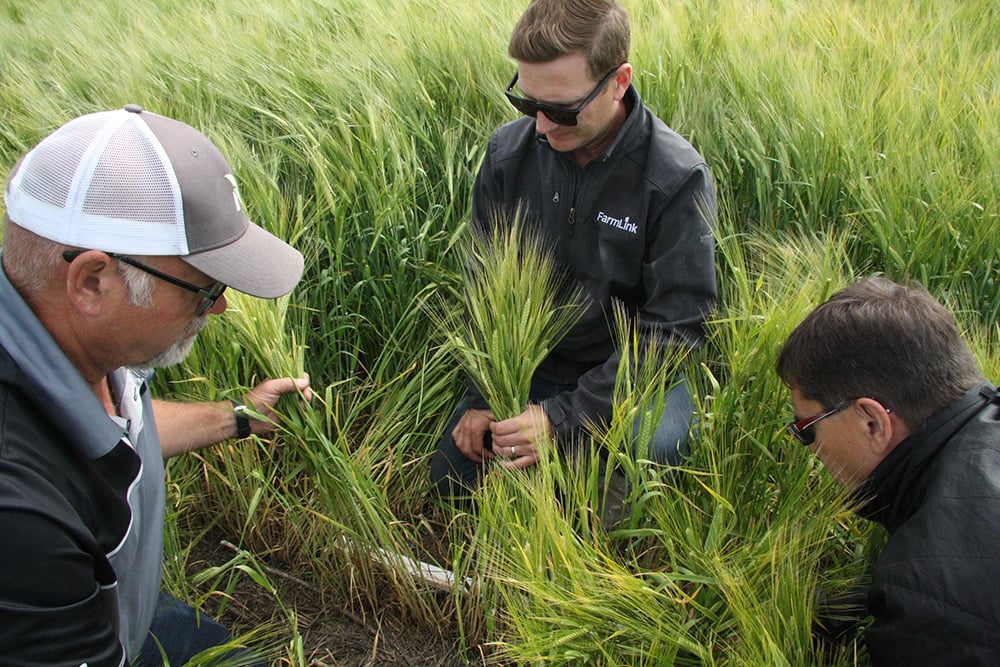The tillers farmers typically don’t want in their fields may actually boost cereal crop yields in Saskatchewan’s northeast this year.
Multiple fields observed on last week’s GrainWorld crop tour, organized by FarmLink Solutions, showed tillers taller than main stems and carrying similar numbers of spikelets and seeds.
“We saw this all day yesterday,” said Derek Dery, north Saskatchewan manager for FarmLink during a stop in a wheat field near Bjorkdale on the second day.
“The tillers that come usually just give you disease and fusarium.”
Read Also

Farming Smarter receives financial boost from Alberta government for potato research
Farming Smarter near Lethbridge got a boost to its research equipment, thanks to the Alberta government’s increase in funding for research associations.
Instead, the late June rains that followed a dry spring appear to have led to widespread tiller development, he said, and those tillers will add significantly to yields.
“Given the seeds and the head size, (the tiller) is actually contributing to the most yield” in many cases, he said.
Dailen Spedding was OK with that news. He figured his Cameron wheat crop was about a week behind and an estimate of at least 60 bushels per acre was welcome.
“That’s a bit of a surprise to me,” he said.
More stories from the crop tour:
Tour finds above average crops in Saskatchewan, Manitoba
Alberta crops as variable as the rain
Tweets from Grain World Crop Tour
He said seeding rates in general are going up to suppress tillers and he agreed it was odd to see so many.
Near Spalding, Shawn Holter said he seeded at 183 pounds per acre, yet his field of Brandon wheat showed tall, healthy tillers.
Dery, along with FarmLink marketing adviser Rick Taciuk, estimated the average yield at a strong 70 bu. per acre. Their measurements indicated some spots could be more than 90 bu. per acre.
Yield projections are based on plant counts in a three-foot row, the number of spikelets and the number of seeds.
Meanwhile, Holter’s Ruffian oat crop looks to yield more than 200 bu. per acre.
That said, the crops still have to fill and come off the fields. Generally speaking, the crops in the northeast are about a week behind, according to farmers along the tour route.
Most agreed that the dry spring led to the delay and without the rain the picture would be much different.
“So you are telling me I should be putting bins up,” laughed Marius Blitterswijk when presented with a wheat yield estimate of about 87 bu. per acre.
He farms north of the Quill Lakes and although he wishes the rain had come earlier, he said good rains the last couple weeks have moved crops along. His crops range from on time to late.
Further north at Melfort, Dean Hurd said the variability is a problem. His crops are about five to seven days behind.
“Staging is going to be all over the map,” he said. “Frost is a huge concern.”
His oats, wheat, peas and barley all present strong yield potential, perhaps more than he expected. But he is worried the crop isn’t maturing fast enough.
“I’ve still got my flag leaf,” he said looking at the barley. “Usually by this time it’s toast.”
Over at Hagen, Dery told Connor Njaa that wheat that has just finished flowering could yield 57 bu. per acre.
Njaa said germination was late and the crop got only occasional shots of rain. It still needs a good soaking to fill. Like others, it has good tillers to increase yield.
“I think you’re going to be surprised,” said Dery.
Just southwest of Prince Albert, Don Blocka estimated his wheat would yield about 50 bu. per acre and that’s what the assessment showed.
“For us, that’s what we expect or want,” Blocka said. “Last year, we got 40 if we were lucky. It looks a lot better than it did last year.”
Barley yields appeared strong throughout the region, ranging from about 75 bu. per acre to 100.
Merlis Wiebe’s barley at Rosthern was just starting to fill and needs rain. Crops closer to Saskatoon weren’t as good as those further north and east.
His crops, which include flax, canola and corn, are also a little bit behind.
“It’s just stress, drought stress,” he said. “Now we have some moisture, we need enough frost-free days.”


















